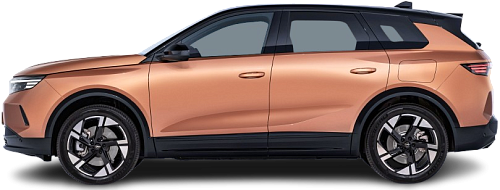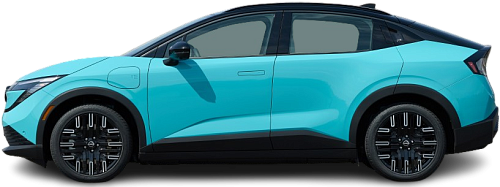USA EV Comparison: Opel Grandland Electric 82 kWh vs Nissan Leaf 75 kWh
Struggling to Decide? Let AI Help!
Your AI Summary Is Ready!
General Info
While the Opel Grandland Electric 82 kWh (2024-…) is currently produced, it is not offered for sale in the United States. The Nissan Leaf 75 kWh (2025-…) is announced, but not yet in production.
The two vehicles share the same body style: SUV.
| Property | Opel Grandland Electric 82 kWh | Nissan Leaf 75 kWh |
|---|---|---|
| Years of Production | 2024-… | 2025-… |
| Current Status | Produced | Announced |
| Country of Manufacture | Germany | Japan, UK, USA |
| Body Style | SUV | SUV |
| Market Availability | EU | EU, USA |
| Price USA (New) | - Price USA (New) | $37000 |
| GCC Score | 6.9 | 5.9 |
Range and Efficiency
While the Opel Grandland Electric 82 kWh (2024-…) offers a longer real-world range and a bigger battery, it is less energy-efficient than the Nissan Leaf 75 kWh (2025-…).
| Property | Opel Grandland Electric 82 kWh | Nissan Leaf 75 kWh |
|---|---|---|
| Range (EPA) | - Range (EPA) | 303 mi |
| Range (WLTP) | 362 mi | - Range (WLTP) |
| Range (GCC) | 311 mi | 288 mi |
| Battery Capacity (Nominal) | 86 kWh | 75 kWh |
| Battery Capacity (Usable) | 82.2 kWh | 71.2 kWh |
| Efficiency per 100 mi | 26.4 kWh/100 mi | 24.7 kWh/100 mi |
| Efficiency per kWh | 3.78 mi/kWh | 4.04 mi/kWh |
| Range and Efficiency Score | 8.6 | 8.4 |
Charging
Both vehicles utilize a standard 400-volt architecture.
The Opel Grandland Electric 82 kWh (2024-…) offers faster charging speeds at DC stations, reaching up to 160 kW, while the Nissan Leaf 75 kWh (2025-…) maxes out at 150 kW.
The Opel Grandland Electric 82 kWh (2024-…) features a more powerful on-board charger, supporting a maximum AC charging power of 11 kW, whereas the Nissan Leaf 75 kWh (2025-…) is limited to 7.2 kW.
| Property | Opel Grandland Electric 82 kWh | Nissan Leaf 75 kWh |
|---|---|---|
| Max Charging Power (AC) | 11 kW | 7.2 kW |
| Max Charging Power (DC) | 160 kW | 150 kW |
| Architecture | 400 V | 400 V |
| Charge Port | CCS Type 2 | Tesla (NACS) |
| Charging Score | 6.6 | 5.1 |
Performance
Both vehicles are front-wheel drive.
The Nissan Leaf 75 kWh (2025-…) boasts greater motor power and accelerates faster from 0 to 60 mph.
| Property | Opel Grandland Electric 82 kWh | Nissan Leaf 75 kWh |
|---|---|---|
| Drive Type | FWD | FWD |
| Motor Type | PMSM | PMSM |
| Motor Power (kW) | 157 kW | 160 kW |
| Motor Power (hp) | 211 hp | 214 hp |
| Motor Torque | 254 lb-ft | 261 lb-ft |
| 0-60 mph | 8.6 s | 6.8 s |
| Top Speed | 106 mph | 106 mph |
| Performance Score | 3.5 | 3.7 |
Dimensions
The Opel Grandland Electric 82 kWh (2024-…) is longer, wider, and taller.
The Opel Grandland Electric 82 kWh (2024-…) boasts a more extended wheelbase.
| Property | Opel Grandland Electric 82 kWh | Nissan Leaf 75 kWh |
|---|---|---|
| Length | 183.1 in | 173.4 in |
| Width (with Mirrors) | 83 in | 82.6 in |
| Width (w/o Mirrors) | 76.1 in | 71.3 in |
| Height | 65.4 in | 61.3 in |
| Wheelbase | 110 in | 105.9 in |
Cargo and Towing
The Nissan Leaf 75 kWh (2025-…) features a larger trunk, but the Opel Grandland Electric 82 kWh (2024-…) offers greater maximum cargo capacity when the rear seats are folded.
Neither car is equipped with a frunk (front trunk).
The Opel Grandland Electric 82 kWh (2024-…) has a towing capacity of up to 2646 lb, whereas the Nissan Leaf 75 kWh (2025-…) is not officially rated for towing in the US.
| Property | Opel Grandland Electric 82 kWh | Nissan Leaf 75 kWh |
|---|---|---|
| Number of Seats | 5 | 5 |
| Curb Weight | 4894 lb | 4187 lb |
| Cargo Volume (Trunk) | 19.4 ft3 | 20 ft3 |
| Cargo Volume (Max) | 58.1 ft3 | 55.5 ft3 |
| Cargo Volume (Frunk) | - Cargo Volume (Frunk) | - Cargo Volume (Frunk) |
| Towing Capacity | 2646 lb | - Towing Capacity |
| Cargo and Towing Score | 7.3 | 5.8 |




